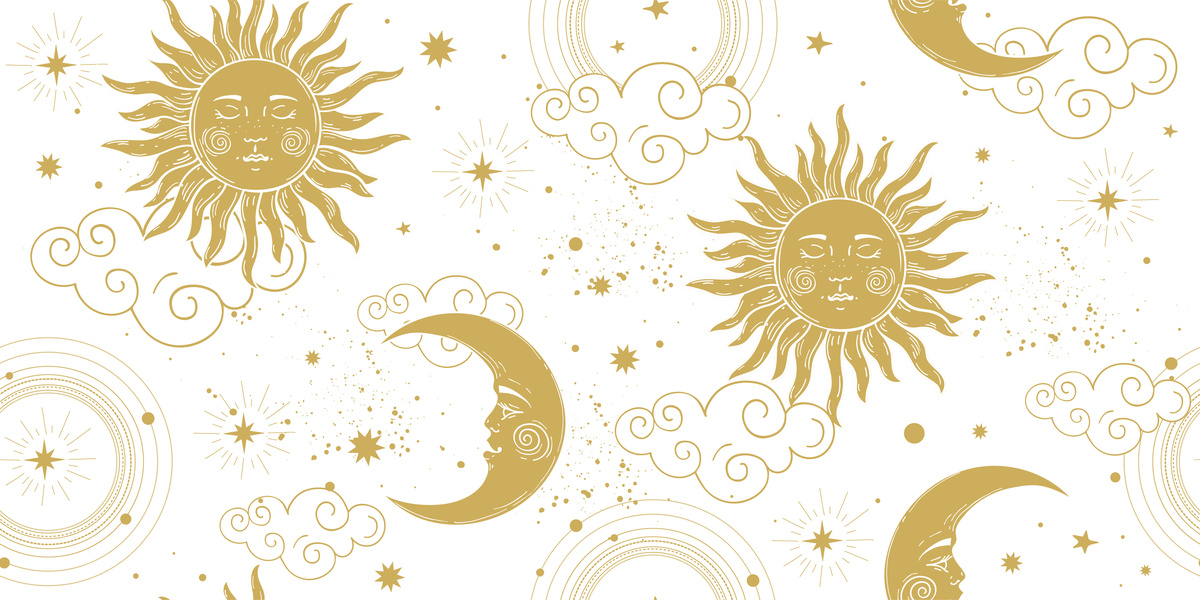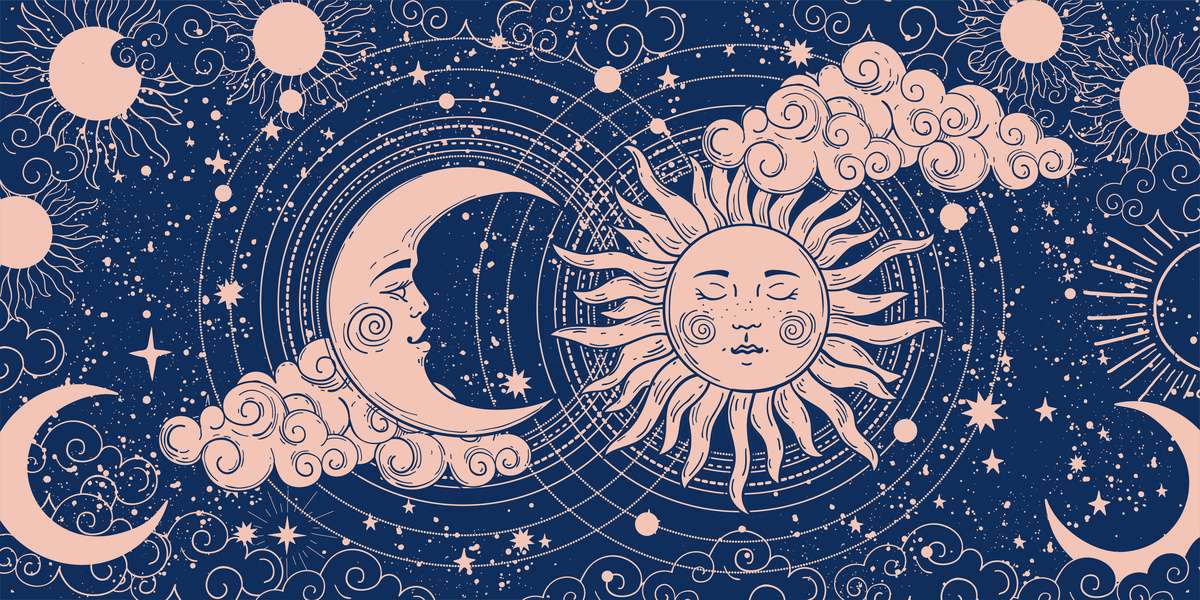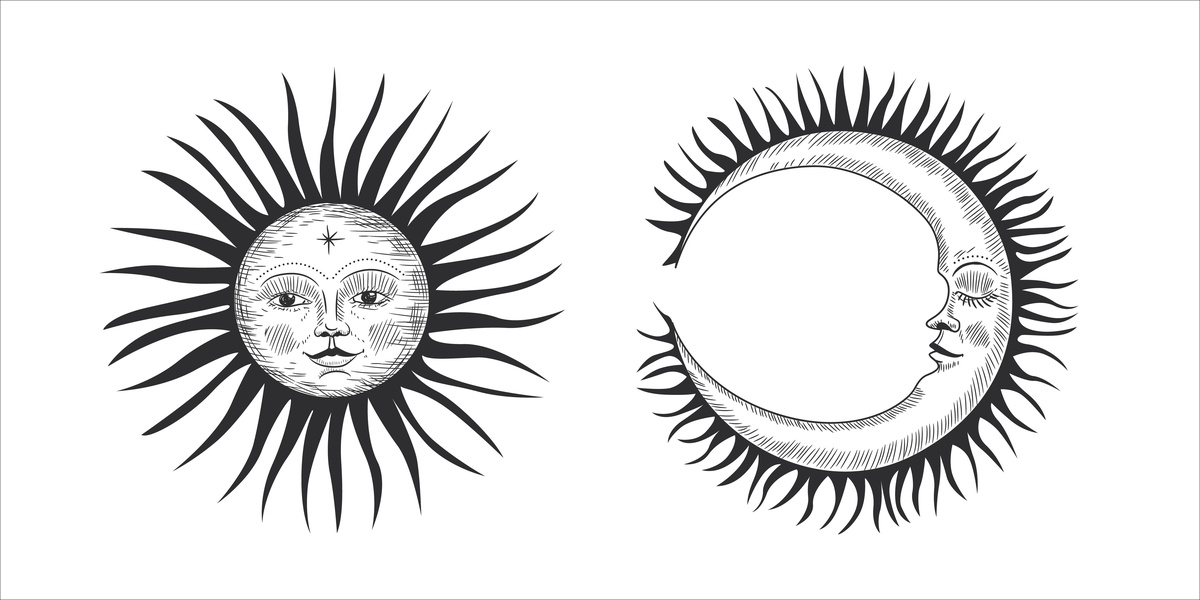Table of contents
The different versions of legends of the Sun and the Moon

In the early days of humanity, our ancestors were impressed by the grandeur of the stars and the mysteries that the sky concealed. In various places on our planet, since the first records of human existence, people saw in the Sun and the Moon the rulers of life.
Due to the importance of the Sun on earth for the production of food and the safety that the Moon provides in the dark, the first inhabitants of Earth surrounded their figures with mysticism and sought to explain their presence from legends and myths rich in symbolism and history that endure until today within numerous beliefs.
There are many legends and myths that were created around the Sun and the Moon. In most ancient mythologies, there are gods or creatures representing these forces. In this article, we will understand a little bit how these stars were represented in some belief systems, as in the Tupi-Guarani, Aztec, Celtic mythologies and many others. Check it out!
The legend of the Sun and the Moon in Tupi-Guarani mythology

Tupi-Guarani mythology has a complex and even independent system of legends that explain everything from the creation of the world to the creation of human beings. The primary figure of creation is Iamandu or Nhamandú which in other versions may be called Nhanderuvuçu, Ñane Ramõi Jusu Papa - "Our Great Eternal Grandfather" or, still, Tupã.
For the Guarani-Kaiowá, Ñane Ramõi was formed from an original substance called Jasuka and then created the other divine beings, as well as his wife, Ñande Jari - "Our Grandmother." He also created the Earth, the sky, and the forests. However, he lived on Earth for a short time before it was occupied by humans, leaving it after disagreements with his wife.
The son of Ñane Ramõi, Ñande Ru Paven - "Our Father of All" and his wife, Ñande Sy - "Our Mother", became responsible for dividing the Earth among the peoples and created various survival tools for humans. Ñande Ru Paven following the example of his father, also abandoned the Earth because of jealousy, leaving his wife pregnant with twins. From this, the brothers were born Pa'i Kuara e Jasy which were chosen to protect the sun and the moon, respectively.
For the Tupi people, Tupã is the father figure creator of the Universe, who, with the help of the sun god Guaraci, created all living beings. We will understand below how these solar and lunar energies are represented in Tupi-Guarani mythology.
The story of the indigenous legend about the Sun and the Moon
There are several mythological strands within the Tupi-Guarani belief system, as there are many peoples under this title. Following the original legend of Ñane Ramõi, his grandchildren Pa'i Kuara e Jasy After several adventures on Earth, they became responsible for taking care of the Sun and the Moon.
The first one, Pa'i Kuara wishing to find his father, he fasted, danced and prayed for days on end until his body became light enough for his purpose. After proving his strength and determination, his father, Ñande Ru Paven He gave him the sun as a reward, and the moon to his younger brother, Jasy .
The Tupi legends around the majesty of these stars tell that Guaraci - in Tupi, Kûarasy - would be the Sun god, who had the eternal office of illuminating the Earth. One day, having become tired, he needed to sleep and, when he closed his eyes, he placed the world in darkness and gloom.
To illuminate the Earth while Guaraci slept, Tupã created Jaci - in Tupi, Ya-cy She was so beautiful that upon awakening, Guaraci fell in love. Enchanted, the Sun god went back to sleep to find her again, but as soon as he opened his eyes to see her and illuminate the Earth, Jaci lay down, fulfilling his mission.
Then, Guaraci asked Tupã to create Rudá, the god of love, who knew neither light nor darkness, allowing the Sun and Moon to meet at dawn. Many versions can be found about Guaraci and Jaci, which follow the diversification of the Tupi-Guarani indigenous peoples.
Guaraci
In strands of Tupi mythology, the sun god Guaraci helps his father Tupã to create the land creatures, as well as acting as their guardian during the day. He is also the brother-husband of Jaci, the moon goddess.
During the dawn, at the meeting between the Sun and the Moon, the wives ask Guaraci for protection for their husbands who go out hunting.
Jaci
The moon goddess Jaci is the protector of plants and guardian of the night. She rules fertility and lovers. She is the sister-wife of Guaraci, the sun god.
One of her roles is to arouse longing in the hearts of men when they go out hunting, so as to hasten their return home.
The legend of the Sun and the Moon in different cultures

Many are the cults directed to the Sun and the Moon in various cultures around the world. The stars and the sky have always been representatives of the divine power and presence and, due to their influences on terrestrial life, were considered gods. We will see below how the mythologies around the globe understood and explained the astral energies.
The Aztec Myth
The Aztecs were a people who inhabited the center-south where Mexico is today, and who had a mythology rich in gods and supernatural beings. For them, there were five suns, and our world would be represented by the fifth. For the creation of the world, a sacrifice from a god was required.
For the creation of the Earth, the god Tecuciztecatl would have been chosen. As he sacrificed himself, throwing himself on a fire, he recoiled in fear and a poor, humble little god Nanahuatzin ...he launched himself in his place, becoming the sun. When he saw that.., Tecuciztecatl The other gods sacrificed themselves as well, creating the water of life.
For the Aztecs, the stars were to be kept alive with the recreation of this original divine sacrifice. They believed that they possessed this mission among the other peoples and therefore sacrificed prisoners of war so that the stars would be fed and kept alive until the end of time.
The Sun and the Moon for the Maya
Mayan mythology is extensive and has legends for various natural aspects, such as rain and agriculture. For the Sun and the Moon, the Mayans held the belief that two brothers, Hunahpu e Xbalanque , full of life and pride when it came to ball games, were taken to the Underworld ( Xibalba ) on account of his exploits.
The Lords of Death had already taken the boys' father and uncle, who were also twins and vain of their ball talents, but having failed the challenges, they were killed. So the Lords summoned the twins and subjected them to the same tests that the father and uncle passed. But the two, deceiving the Lords of Death, passed them all unharmed.
Until, realizing that their luck would soon run out, the twins decided to accept one last challenge, which consisted of entering a burning furnace. Then, the Lords of Death shredded their bones and splashed them into a river, from where they were both reincarnated in various forms, the last of them into two roving magicians.
The two magical brothers were so skilled that they were able to sacrifice people and then bring them back to life again. The Lords of Death, hearing of their exploits, demanded a demonstration in the underworld. Impressed by the twins' resurrecting abilities, they asked them to perform the trick on some of them.
However, after making the initial sacrifice, Hunahpu e Xbalanque refused to bring them back to life, taking revenge on the Death Lords and ending the glory days of the Xibalba Then, after that, they were lifted up into the sky in the forms of the sun and the moon.
The Eskimo Legend - Inuit mythology
People who live in the Arctic Circle survive exclusively by hunting animals and fish, as the land is inhospitable to cultivation. Inuit mythology is animalistic, with the belief that spirits take the form of animals. The shaman is the one who contacts these spirits and knows the secrets of the supernatural world.
For these people, the Moon is Igaluk and the sun is Malina According to legend, Igaluk was the brother of Malina and raped her own sister during the night. Not knowing who had molested her, Malina decided to mark her attacker when, the following night, the violence was repeated.
When he saw that it was his brother, Malina ran away carrying a torch and was pursued by Igaluk Then the two ascended into the sky, becoming the sun and the moon respectively.
The mythology of the Navajo people
The Navajo people are northern natives who occupy part of the United States. Their culture and livelihoods are based on hunting and fishing. Their spiritual philosophy is based on the balance between man and nature, and sometimes the simplest creatures have greater meaning and importance than large ones.
The rites of the Navajo people are based on the sun, for the star represents fertility, warmth and life. According to legend, Tsohanoai is the sun god, who has a human form and carries this star on his back every day. During the night, the sun rests hanging on the western wall of the house of Tsohanoai .
The Moon, for these people, is called Kléhanoi the weaker brother of the Sun, which complements and amplifies its nature.
Celtic Mythology
The Celts had a mythology all based on nature, its cycles and processes, and there were no gods superior to each other in importance, because for them, all were representatives of the two main energies: feminine and masculine.
They believed that life was ruled by the Sun and considered the seasons and equinoxes very important to their belief. The representative god of the Sun is Bel, although he sometimes appears under the name of Lugh .
The moon was represented by Cerridwen She is the triple goddess of Celtic mythology, presenting a face for each phase of the moon - maiden on the crescent moon, mother on the full moon and elderly on the waning moon.
The Moon is the representative of the sacred feminine, of the regency of the tides and plant fluids, of fertility and feminine cycles, as well as the power of creation of life.
The Sun and the Moon in Australian Aboriginal mythology
Australian Aboriginal mythology has a very detailed belief system, which understands that there are three main realms - the human, the earthly and the sacred. Before the creation of the world as we know it today, there was an age called Dreamtime or Dreamtime.
In that era, a young woman was forbidden to live in love with her beloved. Frustrated, she plunged into the forest, far from food and protection, finding increasingly unfavorable conditions. Seeing the young woman on the verge of death, the spirits of her ancestors decided to intervene and took her to heaven, where she found food and fire to warm herself.
From there, she could see the difficulties her people faced due to lack of heat. So she decided to make the biggest bonfire she could, creating the Sun. Since then, she lit the bonfire every day to keep the people warm and encourage the cultivation of food.
Still in the Dreamtime, a hunter named Japara He went out hunting, leaving his wife and son behind. In his absence, a wanderer found his wife and unraveled incredible stories that left her thoroughly entertained. Her concentration was only broken when she heard a thud in the water - her son had fallen into the current and, despite her efforts, ended up dying.
Because of this misfortune, she spent the whole day crying and waiting for Japara When she told him what had happened, the husband had an outburst of rage and blamed her for the death of his son, killing her, Japara came to his senses and understood the completeness of his errors.
So he went out in search of the bodies of his family. Seeing that they had disappeared, he begged the spirits to reunite with them. As an act of mercy, the spirits allowed him to Japara Since then, he has wandered the sky in the form of the moon in his never-ending search.
The Sun and the Moon for the Efik people
The Efik people populated the region of Nigeria and Cameroon. According to the traditional tale of these people, the Sun, Moon and Water lived on Earth and were good friends. The Sun often visited the Water, which did not return his visits.
One day, the Sun invited her to visit his home and his wife the Moon, but Water refused, fearing that her people - all the aquatic creatures - would not fit in her house. The Sun, then, determined to welcome his friend, began to build a larger home. Then, having finished, he called Water to finally return the visit.
When Water arrived with all her people, she questioned the Sun if her home was safe for all to enter. After the star's positive response, she slowly entered, lifting the Sun and the Moon as she went about occupying the home. Again, Water asked twice more if the hosts wished more of the people to enter.
As soon as everyone entered, the Water overflowed the roof, throwing the stars into the sky, where they have remained until today.
The ten Chinese suns
According to Chinese legend, there were ten suns, one for each day of the week - which, for them, had 10 days. They traveled every day with their mother, Xi-He to the valley of light, where there was a lake and a tree called Fu-Sang From this tree, only one of the suns would travel on and appear in the sky to the west, then return to its brethren at the end of the day.
Tired of this routine, the ten suns decided to appear all at once, making the heat on Earth unbearable for life. To prevent the destruction of Earth, the Emperor asked the father of the suns, Di-Jun so that he would encourage his children to show up one at a time.
Despite their father's pleas, the ten suns did not obey. So, Di-Jun asked that the archer Yi scared them off. Yi ...was able to reach nine of the ten suns, keeping only one.
The Egyptian Sun God
The Egyptian god Ra , or, in some places, Tuna is one of the main deities of the Egyptian religion, represented as the Sun god. As Bluefin Tuna was worshipped as the first being and creator of the whole pantheon of nine gods and of all things, as well as human beings.
He was represented by the figure of a man with a falcon head and the solar disk above it. He was also portrayed as a beetle, a ram, a phoenix, a heron, among other animals.
There are several versions of the birth of the god Ra According to one of them, he was born in the Primordial Ocean, within the petals of a lotus flower. Everyday, Ra He was the first king to inhabit the earth and ruled the world with rigor like the sun, which illuminates all the gaps.
Why are there different legends of the Sun and Moon?

It is remarkable the fascination that the stars influence the various cultures around the world and that, even today, are surrounded by mysticism. For primitive peoples and our ancestors, the Sun and Moon are representatives of divine energies and personifications of the gods.
The stars instigate curiosity and, to try to explain and understand the processes of life, the first peoples created systems of legends and myths around the Sun and the Moon, taking into account the importance they have for governing the seasons, the harvests, the tides and even our moods.
These legends were the basis for humanity. If today we have the various information, astronomical and astrological knowledge, and even technology to reach the moon, much is due to the initial curiosity to look at the sky and try to understand what surrounds us.

